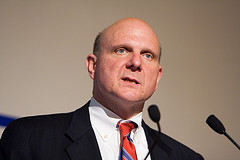|
|
|
Friday, November 22nd, 2013
A Friday series exploring Startups and the people who make them go. Read all If the Shoe Fits posts here

Everyone is talking about Steve Ballmer’s words in a WSJ interview, “Maybe I’m an emblem of an old era, and I have to move on,” and the agreement it drew from Salesforce.com’s CEO Marc Benioff.
Benioff doesn’t care about age, born in 1964 he’s no spring chicken, but he does care about attitude.
“The world has changed. The companies that are struggling in the market today have not gone cloud. They have not gone social. They have not gone mobile. They are still trying to sell the same old stuff.”
Consider all the folks you didn’t hire because they “didn’t fit in,” which was a nice way of saying they were older than you/your friends.
Now consider that in 2009 80% of “total entrepreneurial activity” was over 35 and that hasn’t changed.
No one accuses Salesforce.com of lagging behind or slacking on innovation.
Larry Page turned 40 this year, but Google isn’t exactly sitting back on its laurels or ignoring whatever part of the changing landscape they aren’t changing themselves.
If someone said they knew a great 46 year old design guy how interested would you be?
Is 46 a turnoff?
Oops; you just missed out on Jony Ive.
Image credit: HikingArtist
Posted in Entrepreneurs, If the Shoe Fits | No Comments »
Tuesday, September 24th, 2013

What could Larry Page’s Google possibly have in common with Steve Ballmer’s Microsoft?
Would you believe corporate culture?
Google, long held up an example of great culture is, in fact, as political and siloed as Microsoft.
Not only similar siloed cultures, but a similar approach to changing them.
Ballmer believes that a deeply entrenched culture can be changed by edict and apparently Page does, too.
Page laid down the law: “If you keep fighting, we’ll be very happy to send you to the competition.
“During the speech, one of the executives who was in the room turned to a friend and whispered:“Did he just say, ‘zero tolerance for fighting? I’ve been here for years. All we do is fight.”
If Page is serious about the ‘change or else’ approach you can count on seeing high turnover at Google.
But don’t hold your breath, because words don’t always mean what they say.
Words are interpretive, so people tend to assign their own meanings and put their own spin on what is said.
Says a source who heard the Larry Page sermon at the Carneros Inn: “What he meant by ‘zero tolerance for fighting’ is don’t go overboard.”
This source says there is a “healthy way” to fight at Google.
“The healthy way to fight is to wear two hats.”
“You’ve got to wear your YouTube or Android hat,” the source says. “But the mature executive at Google knows when to put on the Google hat.”
Politics and infighting can only exist if they are openly accepted or covertly tolerated.
As one longtime Google executive put it: “If the princes [are at] war, it’s because the king tolerates it.”
Who knew?
Flickr image credit: mshamma
Posted in Ducks In A Row | No Comments »
Tuesday, August 27th, 2013

Common wisdom says that the larger a company the harder it is to get management to listen, especially when it goes against fundamental corporate practice.
Franchises are even worse and the longer they’ve been around the less they are likely to listen to a franchisee, let alone a new one.
But when they do the result can go way beyond the most optimistic prediction.
The frozen-yogurt giant credits the 32-year-old’s success with pushing them to embrace the self-serve model – a move that has reinvigorated the company and led to exponential growth.
TCBY had been around 30 successful years when Samuel Batt was approved for a new franchise in 2010.
He grew up eating TCBY, but wanted to incorporate self-service—enabling customers to choose flavors, toppings and quantity of each—in his new franchise.
Sounds old hat today, but DIY was just gaining traction in new venues back then.
Long story short; the powers-that-be said yes, as long as he kept the branding.
And within three weeks, his location was one of the top-five most profitable franchises in the country. (…) About half of TCBY’s nearly 500 franchises across the country have embraced the new model to great success, each doing from 25 percent to 200 percent better in sales than with the traditional model, Brian Mooney, director of operations for the Eastern U.S., said.
Management could have just as easily said no.
Compare TCBY’s attitude to Steve Ballmer’s at Microsoft; they are close to the same age—TCBY is just six years younger than Microsoft.
In 2007 Ballmer said, “There’s no chance that the iPhone is going to get any significant market share.”
He didn’t listen to either his own people or the industry when they said that mobile and the cloud were the future—or maybe he was in denial.
But as I recall, Bill Gates didn’t listen when staff tried to tell him that the Internet was going to be really, really BIG.
Bosses at every level, not just CEOs, have a choice.
They can choose to listen and be flexible—or not.
Flickr image credit: jessica mullen
Posted in Culture, Ducks In A Row, Innovation | No Comments »
Wednesday, July 24th, 2013
 When Microsoft announced its much ballyhooed new strategy and resulting management changes I commented that you can’t change culture, especially an intentionally siloed culture, by edict. When Microsoft announced its much ballyhooed new strategy and resulting management changes I commented that you can’t change culture, especially an intentionally siloed culture, by edict.
I didn’t go into what seemed to me a strategy with a serious lack of solid content; these days we all know that not only is content king, but the it’s source of authenticity.
I assumed that it was my unwillingness (boredom) to read the analysis offered by media, let alone Steve Ballmer’s actual long-winded statement to the Microsofties, that made me miss it.
As has been said over and over by experts, “culture eats strategy for lunch” (breakfast, in come cases), and while clear communications is as great a focus for me as culture, I just couldn’t make myself read it.
Fortunately, Wally Bock at Three Star Leadership has more patience and he offered some great analysis and comments, which are reposted below with his kind permission.
Microsoft and the Strategy of Everything
On July 13, 2013, Microsoft’s CEO, Steve Ballmer sent a lumbering, poorly edited, 2600 word email to Microsoft employees, announcing the company’s new strategy. As awful as the memo was, the strategy is worse.
When I read some of the news accounts, I felt like I was experiencing an updated version of Akira Kurosawa’s classic, Rashomon. In that film, people who participate in the same event each describe it differently. In this case, news organizations that got the same information each describe Microsoft’s new strategy differently.
The New York Times wrote about how “Microsoft Overhauls, the Apple Way.” The Wall Street Journal looked at the same announcement and said that “Microsoft Shake-Up Aims to Speed Products.” And the Mercury News told us that “Microsoft unveils major overhaul in effort to focus on mobile.”
Those very different reports sent me to the Microsoft site and the text of Steve Ballmer’s email. There, he tells us that “We are rallying behind a single strategy as one company.” Sounds good. And what might that single strategy be? Here goes.
“Going forward, our strategy will focus on creating a family of devices and services for individuals and businesses that empower people around the globe at home, at work and on the go, for the activities they value most.”
Try reading that without taking a breath or tripping over tangled syntax. Doesn’t exactly have the ring of “A PC on every desk and in every home” does it?
As I interpret it, Microsoft will make products and provide services which they will sell to individuals and businesses in the US and other countries. Egad! Is there anything Microsoft has chosen not to do?
There’s no focus at all. Being everything to everyone is usually a pretty sure way not to be much of anything to anybody.
And there’s nothing to fire up the passions that drive engagement. Would you really leap out of bed in the morning all charged up to “focus on creating a family of devices and services for individuals and businesses?”
This is not a strategy to build long term, sustainable competitive advantage. It is a strategy for rotting slowly from the inside out.
Thanks, Wally.
Flickr image credit: Masaru Kamikura
Posted in Communication, Culture, Strategy | No Comments »
Tuesday, July 16th, 2013
 I’ve written many times about the importance of breaking down both horizontal and vertical silos (for more click the silo tag), but I don’t believe it can be done with an edict—even if that edict comes from Steve Ballmer. I’ve written many times about the importance of breaking down both horizontal and vertical silos (for more click the silo tag), but I don’t believe it can be done with an edict—even if that edict comes from Steve Ballmer.
This is especially true at a company like Microsoft, where the silos were intentionally built decades ago as part of the corporate structure.
Vertical silos, by nature, create, at the least, rivalry, but, more often, an “us against them” mentality within each silo.
For thousands of Microsofties, that’s the only cultural world they have known; many of them grew up in it, both in terms of years and promotions.
Changing culture is recognized as the most difficult organizational change any company, no matter the size, can undertake.
And one of the greatest error’s a CEO makes is thinking that all he needs on board is his senior staff the rest of people will fall in line.
For most companies, let alone one the size of Microsoft, terminating managers and workers that don’t fall in line isn’t even an option, since there is no way to replace them.
Yet having large numbers of your workforce on different cultural pages is a recipe for disaster.
The results of Ballmer’s changes will unfold over the next couple of years—in spite of Wall Street’s quarterly focus.
Changing culture is tremendously difficult; Charlie Brown didn’t pull it off at AT&T; Lou Gerstner said it was the most difficult part of turning around IBM.
Do you think Ballmer will succeed?
Flickr image credit: Tobyotter
Posted in Change, Culture, Ducks In A Row | 4 Comments »
|
 Subscribe to
Subscribe to
MAPping Company Success
About Miki 
Clarify your exec summary, website, etc.
Have a quick question or just want to chat? Feel free to write or call me at 360.335.8054
The 12 Ingredients of a Fillable Req
CheatSheet for InterviewERS
CheatSheet for InterviewEEs™
Give your mind a rest. Here are 4 quick ways to get rid of kinks, break a logjam or juice your creativity!
Creative mousing
Bubblewrap!
Animal innovation
Brain teaser
The latest disaster is here at home; donate to the East Coast recovery efforts now!
Text REDCROSS to 90999 to make a $10 donation or call 00.733.2767. $10 really really does make a difference and you'll never miss it.
And always donate what you can whenever you can
The following accept cash and in-kind donations: Doctors Without Borders, UNICEF, Red Cross, World Food Program, Save the Children
*/
?>About Miki
About KG
Clarify your exec summary, website, marketing collateral, etc.
Have a question or just want to chat @ no cost? Feel free to write
Download useful assistance now.
Entrepreneurs face difficulties that are hard for most people to imagine, let alone understand. You can find anonymous help and connections that do understand at 7 cups of tea.
Crises never end.
$10 really does make a difference and you’ll never miss it,
while $10 a month has exponential power.
Always donate what you can whenever you can.
The following accept cash and in-kind donations:
|







 When Microsoft announced its much ballyhooed new strategy and resulting management changes I commented that you
When Microsoft announced its much ballyhooed new strategy and resulting management changes I commented that you  I’ve written many times about the importance of
I’ve written many times about the importance of 
